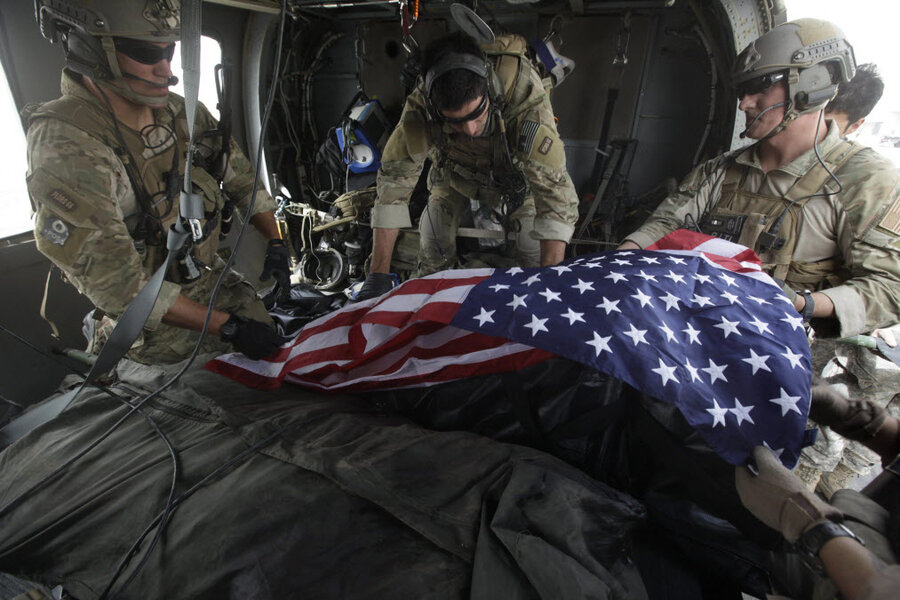Afghanistan war claims 2,000th US soldier, but pace slowing
Loading...
| Kabul, Afghanistan
A possible insider attack has claimed the life of America’s 2,000th soldier to die in Afghanistan. The shooting reportedly took place Saturday evening in Afghanistan’s volatile Wardak Province at a checkpoint run by the Afghan Army.
While initial reports indicated that the incident was likely an insider attack, international military officials now say insurgent fire may have been involved. The incident left one NATO soldier presumed to be American dead, along with a civilian contractor, and three Afghan soldiers. Afghan and international military authorities are now investigating the incident.
If confirmed as an insider attack, the incident is likely to carry particular significance beyond being the 2,000th American soldier killed in the nearly 11-year conflict. Though violence has fallen here with US troops seeing consistent drops in fatalities starting last year, the war continues to claim lives and this latest spate of insider killings presents a challenge that has so far eluded US and NATO efforts to solve the problem.
“It gets at the very core of trust between coalition forces and the Afghans, and it’s very difficult to counter,” says David Barno, a senior fellow at the Center for a New American Security who commanded US and international forces in Afghanistan from 2003 to 2005.
Citing findings that show insurgent infiltration accounts for only a quarter of insider attacks, with personal disputes accounting for another quarter and the rest having unclear motivations, Mr. Barno says stopping the attacks will be difficult.
“You can come up with a counterintelligence program and take a number of other measures to help find Taliban infiltrators, but if 3 out of 4 attacks are related to cultural misunderstandings, outbursts, or friction perhaps related to 11 years of exposure between the coalition and Afghans that’s much more perplexing and much more difficult to deal with,” he says.
As US forces increasingly focus on the training mission ahead of the end of their combat operations, scheduled for 2014, the insider killings present a significant threat. If the most recent American death is confirmed as a so-called green-on-blue attack, when an Afghan soldier kills an American service member, such incidents will account for 53 NATO deaths this year alone, or roughly 15 percent of those killed in Afghanistan.
NATO recently introduced severely restricted joint operations with Afghan forces in an effort to address the problem. But few Afghan units are judged by NATO as ready to operate alone, leaving some international forces on the ground looking to continue joint operations as a means of wrapping up the mission. Meanwhile, the most recent incident suggests that efforts by Afghan and NATO forces to screen the fledgling security forces for possible turncoats will require still more work.
“The recruitment of Afghan security forces was done mostly to reach the numerical goals, not to recruit quality soldiers,” says Hilaludin Hilal, a former deputy of the Ministry of Interior. “The very urgent and short-term solution must come from the Afghan government. They must start screening and filtering these forces and kicking out anyone who poses a threat."
At the end of 2003, the Afghan security forces numbered just 6,000 personnel. Today there are 352,000, with the force nearly doubling in size between the summer of 2009 and now.
“Insider attacks, though tragic, will not derail ISAF from achieving its mission nor will it weaken the collective resolve and bonds of our Coalition and Afghan partners,” says US Air Force Maj. Lori Hodge, a spokesperson for the International Security Assistance Force. “The partnership between Afghan and coalition forces remains very strong, and together we are committed to helping the people of Afghanistan build a prosperous future.”
Fighting in Afghanistan claimed the most American lives in Afghanistan in 2010, and since then the number of Americans killed here each year has dropped. Though Afghanistan has seen an overall reduction in fighting and violence, the decrease in NATO deaths may come in part from a greater focus on training Afghan security forces and a reduction in the number of international forces here. Just this month, the last US surge troops left Afghanistan, bringing the number of American soldiers here down to 68,000.
Counts for the death toll in Afghanistan vary based on different organizational counting practices. The Associated Press count, which now logs 2,000 dead, counts those service members killed inside Afghanistan during the course of the current war. Other counts include those killed in other countries working in support of antiterrorism operations related to Afghanistan.








